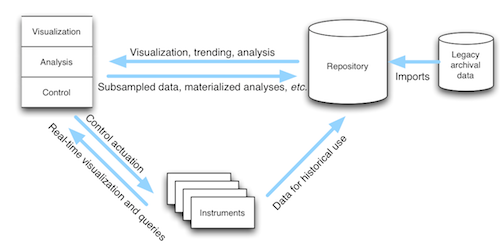-
Notifications
You must be signed in to change notification settings - Fork 35
Home
Welcome to the sMAP wiki!
###sMAP: the Simple Measurement and Actuation Profile An enormous amount of physical information; that is, information from and about the world is available today as the cost of communication and instrumentation has fallen. However, making use of that information is still challenging. The information is frequently siloed into proprietary systems, available only in batch, fragmentary, and disorganized. The sMAP project aims to change this by making available and usable:
- a specification for transmitting physical data and describing its contents,
- a large set of free and open drivers with communicating with devices using native protocols and transforming it to the sMAP profile, and
- tools for building, organizing, and querying large repositories of physical data.
The core object in sMAP is the timeseries, a single progression of (time, value) tuples. Each timeseries in sMAP is identified by a UUID, and can be tagged with metadata; all grouping of time series occurs using these tags. These objects are exchanged between all components in this ecosystem.
- sMAP Introduction
- Installation
- Retrieving data using Python
- Setup
- Basic Access by UUID
- Access by sMAP Query
- Additional Library Functionality
- Retrieving data using R
- Setup
- Basic Access by UUID
- Access by sMAP Query
- Additional Library Functionality
- sMAP source tutorial
- Patterns for driver writing
- The sMAP Archiver Interface
- ArchiverAPI
- Query Language
- Real-time data access
- Manual data publication (JSON Edition)
- CSV Edition
- sMAP toolbox
- smap-query
- smap-tool
- smap-monitize
- smap-load
- smap-load-csv
- Additional topics
- sMAP source conf file syntax
- Programatically creating sMAP sources
- Loading sources from config files
- Driver Index
- Additional Resources
###Indices and tables
- Index
- Module Index
- Search Page
